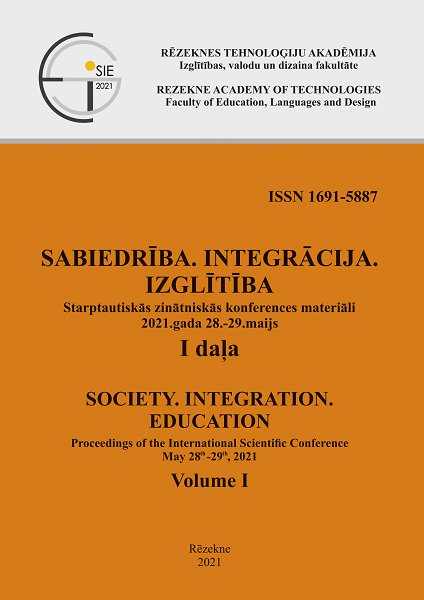CRITERIA AND INDICATORS OF THE DEVELOPMENT OF MUSICIAN’S TIMBRE HEARING
DOI:
https://doi.org/10.17770/sie2021vol1.6191Keywords:
timbral hearing, criteria, indicatorsAbstract
Musical practice constantly lays down requirements to a musician’s hearing. An important tendency of a contemporary musical thinking is the intensification of the timbral beginning, which now starts to come to the foreground as one of the most significant expressive and form-developing means.
Timbre hearing is one type of harmonic hearing (Teplov, 1947) and one of the most essential components at teaching a contemporary musician’s hearing, though in the teaching practice it has not been adequately reflected as yet. The development of the ability of hearing to perceive the expressive sense of a timbre sounding is a vital condition for achieving professionalism in a musician’s musical-performing activity. The precondition for a successful development of musical hearing, including that of timbre, is the process of diagnosticating its actual developmental level, which will help a teacher to organize a student’s musically-practical activity.
The paper offers criteria and indicators for identifying the developmental level of musician’s timbre hearing.
Research Aim: to study the theoretical basis of timbre hearing and to develop criteria and indicators of its development.
Research methods: monitoring, modelling.
References
American National Standart Institute, Asoustical Society of America. (1973). American National Standard Psychoacoustical Terminology. American National Standards Institute
Dinther, R. & Patterson, R.D. (2006). The perception of size in musical instruments. Retrieved from https://www.researchgate.net/publication/6727562_Perception_of_acoustic_scale_and_size_in_musical_instrument_sounds
Handel, S. (1995). Timbre perception and auditory object identification. In B. C. J. Moore (Ed.), Hearing (pp. 425–461). New York: Academic Press.
Handel, S., & Erickson, M. L. (2004). Sound source identification: The possible role of timbre transformations. Music Perception, 21, 587–610.
Karaseva, M. (2009). Solfeggio - Psychotechnics for the Development of Musical Hearing. Moscow: Composer.
Kirnarskaya, D. (2009). The Natural Musician: on Abilities, Giftedness and Talent. Oxford University Press,
Levitin, D. J., & Rogers, S. E. (2005). Absolute pitch: Perception, coding, and controversies. Trends in Cognitive Science, 9, 26–33.
Lyon, R. & Shamma, S. (1996). Auditory Representations of Timbre and Pitch. Retrieved from https://link.springer.com/chapter/10.1007/978-1-4612-4070-9_6
McLachlan, N. M., (2016). Timbre, Pitch, and Music. Retrieved from https://www.oxfordhandbooks.com/view/10.1093/oxfordhb/9780199935345.001.0001/oxfordhb-9780199935345-e-44
McLachlan, N. M., Marco, D. J. T., & Wilson S. J. (2013). Consonance and pitch. Journal of Experimental Psychology: General, 142, 1142–1158. doi:10.1037/a0030830
Starcheus, M. (2003). The musician's hearing. Moscow: P.I. Tchaikovsky Moscow State Conservatory.
Swanwick, K. (1999). Teaching Music Musically. London, New York: Routledge.
Teplov, B. (1947). Psychology of Music and Musical Abilities. Moscow, Leningrad: Izdatelstvo Pedagogicheskih Nauk
Waters, S. (1994). Timbre Composition: Ideology, Metaphor and Social Process. Contemporary Music Review, 10(2), 129–134.






